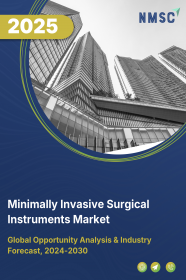
Minimally Invasive Surgical Instruments Market by Product (Handheld Instruments, Electrosurgical Instruments, Guiding Devices, Inflation Systems), by Application (Neurosurgery, Cosmetic Surgery, Urology, Obstetrics & Gynecology, Ophthalmology, Cardiovascular, Orthopedic Surgery, Laparoscopy, and Other Applications), by End-User (Hospitals, Ambulatory Surgical Clinics, and Research Institutes)– Global Opportunity Analysis and Industry Forecast 2020-2030
Market Definition
The Global Minimally Invasive Surgical Instruments Market was valued at USD 20.5 billion in 2019 and is predicted to reach USD 44.04 billion by 2030 with a CAGR of 7.2% from 2020-2030.
Minimally invasive surgery refers to a surgical procedure that is performed using small tools and cameras to limit the size of incision and number of cuts. This procedure is much safer as compared to conventional open surgery as it causes less pain, minimal loss of blood and allows quick recovery of the patient. Due to these numerous benefits, minimally invasive surgery procedure is widely adopted by surgeons as well as patients all over the world to perform various surgeries such as cardiothoracic, neurological and orthopedic among others.
Market Dynamics and Trends
The increase in the prevalence of various disorders such as arthritis, cardiovascular disorders, and others coupled with constant increase in the bariatric surgeries are expected to fuel the minimally invasive surgical instruments market. Also, factors such as constant improvement in minimally invasive surgical instruments, faster recovery, and increased success rates are further expected to contribute towards the growth of the market.
Moreover, surging geriatric population and increasing number of surgeries associated with them, such as orthopedic surgeries, cardiac surgeries, and others are the factors expected to drive the growth of minimally invasive surgical instruments market.
However, high cost associated with the surgery, lack of skilled surgeons and inadequate sterilization procedures are the factors expected to hamper the market growth to some extent. On the other hand, developments in emerging markets and increasing awareness towards advanced procedures in MIS are factors expected to create lucrative opportunities for the growth of minimally invasive surgical instruments market during the forecast period.
Market Segmentations and Scope of the Study
The global minimally invasive surgical instruments market is analyzed on the basis of product, application, end-user and geography. On the basis of product, the market is classified into handheld instruments, electrosurgical instruments, guiding devices and inflation systems. The handheld instrument is further divided into forceps & spatulas, retractors, dilators, graspers, sutures, visualizing scopes, auxiliary instruments, cutter instruments and others. The auxiliary instruments are also sub-segmented into clamps, staplers, cannulas and closure devices. The cutter instruments segment is further classified into trocars, rasps and others (Scissors, Dissectors, and Blades). The electrosurgical instruments are categorized into electrosurgical generators, electrosurgical instruments & accessories, and electrocautery devices. The guiding devices segment is also sub segmented into guiding catheters and guidewire. The inflation systems are also divided into balloons dilators & inflators and insufflators & insufflator needles. On the basis of application, the market is categorized into neurosurgery, cosmetic surgery, urology, obstetrics & gynecology, ophthalmology, cardiovascular, orthopedic surgery, laparoscopy, and other applications. On the basis of end-user, the market is bifurcated into hospitals, ambulatory surgical clinics, and research institutes. Geographic breakdown and analysis of each of the aforesaid segments includes regions comprising of North America, Europe, Asia-Pacific, and RoW.
Geographical Analysis:
North America holds the lion share of the minimally invasive surgical instruments market. This is attributed to factors such as presence of well-established healthcare services, and increasing prevalence of various disorders such as cardiovascular disorders, bariatric surgeries, urology disorders and others in this region. In addition, rising awareness of early diagnosis, and increasing adoption of minimally invasive surgery among citizens also propel the market growth in this region.
However, Asia-Pacific would witness rapid growth in terms of market share owing to rising accessibility to healthcare facilities coupled with growing disposable income and increasing geriatric population in this region.
Competitive Landscape
The minimally invasive surgical instruments market, which is highly competitive, consists of a few major players such as Medtronic PLC, Ethicon, Inc., B. Braun Melsungen Ag, Smith & Nephew PLC, Stryker Corporation, Abbott Laboratories, Conmed Corporation, Applied Medical Resources Corporation, Hoya Corporation, and Zimmer Biomet Holdings, Inc. These major companies have adopted product launch and acquisition as their developmental strategies in the market.
For instance, in September 30, 2020, Medtronic PLC announced acquisition of Avenu Medical, which is mainly focused on the minimally invasive creation of arteriovenous fistulae for patients with end-stage renal disease undergoing dialysis. This acquisition helps to reinforce Medtronic PLC’s commitment to enhance the outcome of patients with final stage Renel disease by using Avenu’s Percutaneous Fistula Creation Technology. Also, in July 28, 2020, Smith & Nephew PLC launched RI.HIP Navigation for total hip arthroplasty which is designed to provide maximum accuracy and reproducibility to patients.
Key Benefits
-
The global minimally invasive surgical instruments market report provides the quantitative analysis of the current market and estimations through 2020-2030 that assists in identifying the prevailing market opportunities to capitalize on.
-
The study comprises a deep dive analysis of the minimally invasive surgical instruments market trend including the current and future trends for depicting the prevalent investment pockets in the market.
-
The information related to key drivers, restraints and opportunities and their impact on the global minimally invasive surgical instruments market is provided in the report.
-
The competitive analysis of the market players along with their market share in the global minimally invasive surgical instruments market
-
The SWOT analysis and Porters Five Forces model is elaborated in the study.
-
Value chain analysis in the market study provides a clear picture of the stakeholders’ roles.
Key Market Segments
By Product
-
Handheld Instruments
-
Forceps & Spatulas
-
Retractors
-
Dilators
-
Graspers
-
Sutures
-
Visualizing Scopes
-
Auxiliary Instruments
-
Clamps
-
Staplers
-
Cannulas
-
Closure Devices
-
-
Cutter Instruments
-
Trocars
-
Rasps
-
Others (Scissors, Dissectors, and Blades)
-
-
Others
-
-
Electrosurgical Instruments
-
Electrosurgical Generators
-
Electrosurgical Instruments & Accessories
-
Electrocautery Devices
-
-
Guiding Devices
-
Guiding Catheters
-
Guidewires
-
-
Inflation Systems
-
Balloons Dilators & Inflators
-
Insufflators & Insufflator Needles
-
By Application
-
Neurosurgery
-
Cosmetic Surgery
-
Urology
-
Obstetrics & Gynecology
-
Ophthalmology
-
Cardiovascular
-
Orthopedic Surgery
-
Laparoscopy
-
Others
By End-User
-
Hospitals
-
Ambulatory Surgical Clinics
-
Research Institutes
By Region
-
North America
-
U.S
-
Canada
-
Mexico
-
-
Europe
-
UK
-
Germany
-
France
-
Italy
-
Spain
-
Rest of Europe
-
-
Asia-Pacific
-
China
-
India
-
Japan
-
Rest of Asia-Pacific
-
RoW
-
Latin America
-
Middle East
-
Africa
-
Key Players
- Medtronic PLC.
- Ethicon, Inc.
- B. Braun Melsungen Ag
- Smith & Nephew PLC
- Stryker Corporation
- Abbott Laboratories
- Conmed Corporation
- Applied Medical Resources Corporation
- Hoya Corporation
- Zimmer Biomet Holdings, Inc.
REPORT SCOPE AND SEGMENTATION
|
Parameters |
Details |
|
Analysis Period |
2019–2030 |
|
Base Year Considered |
2020 |
|
Forecast Period |
2020–2030 |
|
Market Size Estimation |
Billion (USD) |
|
Market Segmentation |
By Product (Handheld Instruments, Electrosurgical Instruments, Guiding Devices, Inflation Systems) By Application (Neurosurgery, Cosmetic Surgery, Urology, Obstetrics & Gynecology, Ophthalmology, Cardiovascular, Orthopedic Surgery, Laparoscopy, Others) By End-User (Hospitals, Ambulatory Surgical Clinics, Research Institutes) |
|
Geographical Segmentation |
North America (U.S., Canada, Mexico) Europe (UK, Germany, France, Italy, Spain, Rest of Europe), Asia-Pacific (India, China, Japan, Rest of APAC), Rest of the World (Latin America, Middle East, Africa) |
|
Companies Profiled |
Medtronic PLC, Ethicon, Inc., B. Braun Melsungen Ag, Smith & Nephew PLC, Stryker Corporation, Abbott Laboratories, Conmed Corporation, Applied Medical Resources Corporation, Hoya Corporation, and Zimmer Biomet Holdings, Inc. |

















 Speak to Our Analyst
Speak to Our Analyst





















